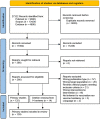Countering vaccine hesitancy: a systematic review of interventions to strengthen healthcare professionals' action
- PMID: 37581903
- PMCID: PMC10567238
- DOI: 10.1093/eurpub/ckad134
Countering vaccine hesitancy: a systematic review of interventions to strengthen healthcare professionals' action
Abstract
Background: Vaccine hesitancy is relevant for healthcare professionals (HCPs) who face challenges in building trusting relationships with patients. Accordingly, the VAX-TRUST project has been developed to improve experiences of HCPs and patients dealing with vaccinations. To support VAX-TRUST, this work aimed to identify latest interventions targeted at HCPs to address hesitancy and increase vaccine uptake.
Methods: A systematic review was conducted according to PRISMA by searching PubMed, Scopus and Embase. The protocol was registered on PROSPERO. Articles were eligible if evaluated interventions directly targeted at HCPs/healthcare students. The search was run on 26 January 2022. Articles published in 2016 or after were included.
Results: A total of 17 492 records were identified; 139 articles were selected. Most articles were set in USA (n = 110). Over half had a pre-post design without a control group (n = 78). A total of 41 articles focused on single-component interventions, 60 on multi-component interventions involving only HCPs and/or students and 38 on multi-component interventions involving also other professionals. Main components were in-person education (n = 76), synchronous (n = 10) and asynchronous (n = 23) online learning, educational materials (n = 26), performance assessment and feedback (n = 33), electronic record changes (n = 30), role play/simulation (n = 21) and online games/apps (n = 5). Educational sessions were mainly about scientific update or communication. Outcomes of interventions were grouped in: vaccination rates (n = 69), knowledge (n = 32), attitudes (n = 26), confidence in counselling (n = 30) and acceptability (n = 16).
Conclusions: Apps, gaming, role play/simulations could represent innovative interventions. This review highlighted the need of delving into communication strategies and using more robust evaluations, longer follow-up and standardized measurements.
© The Author(s) 2023. Published by Oxford University Press on behalf of the European Public Health Association.
References
-
- SAGE Working Group. REPORT SAGE Working Group On Vaccine Hesitancy, 2014. Available at: https://www.who.int/immunization/sage/meetings/2014/october/1_Report_WOR... (10 August 2023, date last accessed).
-
- WHO. Ten Threats to Global Health in 2019, 2019. Available at: https://www.who.int/news-room/spotlight/ten-threats-to-global-health-in-... (10 August 2023, date last accessed).
-
- Hadjipanayis A, van Esso D, Del Torso S, et al.Vaccine confidence among parents: large scale study in eighteen European countries. Vaccine 2020;38:1505–12. - PubMed


